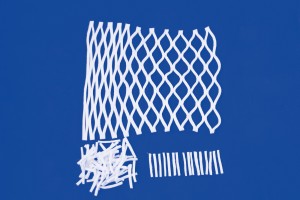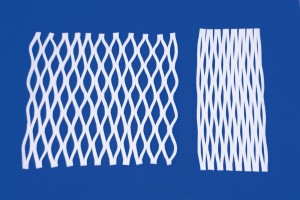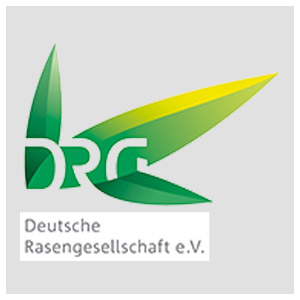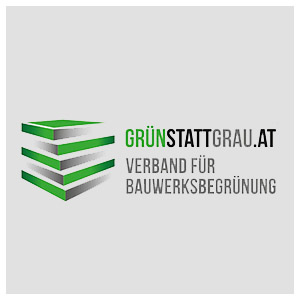The most frequently asked questions about LITE-SOIL products and their applications.
No matter if you’re a hobby gardener or a professional – the sheer amount of information out there about water and air storing products, their advantages and disadvantages for plant growth, and how to use them, can be quite confusing. The search for the ideal product turns out to be a real challenge.
In order to make your decision easier, we have collected the most frequently asked questions about our products:
LITE-SOIL: What is so unique?
When integrated in the ground the 3 dimensional LITE-SOIL products improve the distribution of air and water in the soil, thereby increasing its stability and providing it with better and persistent vegetation.
LITE-SOIL products are strips (LITE-STRIPS) and nets (LITE-NET) cut from thick nonwoven geotextiles or drainage mats. They consist of environmentally friendly, high-strength and rot-proof geotextiles/nonwovens made of long-lasting polypropylene or biologically degradable raw material such as wood fiber or PLA. As these nonwovens contain up to approx. 90% open and interconnected voids, they can drain air and water very well on the one hand and additionally serve as a water reservoir thus fully disposable for the plants.
The open strip or net structure allows the roots to penetrate the mixture with soil, thus LITE-SOIL products can be installed at any required depth.
Unlike other conventional products LITE-SOIL are both air and water storing products and result in better 3-dimensional distribution of water and air in the soil layer. They have a water balance effect: with dry ground they are water storing and with wet ground water draining. LITE-SOIL products store significantly more water than comparable competing products (e.g. LECA). This has been clearly proved by tests carried out by the University of Natural Resources and Life Sciences Vienna (BOKU).
New application possibilities and immense advantages arise from their new, patented design (strips or nets) placed in the soil:
+ Excellent water storage capacity
+ High water transmissivity/drainage capacity
+ Optimal soil aeration
+ Sustainable greening effect
+ Cost-effective
+ Simple installation
+ Installation at any required depth possible
+ Three dimensional installation ossible
+ High flexibility
+ Light weight
+ Erosion protection
+ Particularly most suitable for challenging terrain such as erosion, drought, deserts, silting and slopes
What is new about LITE-SOIL?
LITE-SOIL are made of materials with many years of proven performance in a completely new design. The used retentive nonwovens are adjusted to the soil structure. As they are available as a net or as strips they do not form a barrier anymore for roots and worms. As a result LITE-SOIL products can be installed at any level e.g. at root level and are therefore perfectly adjusted to the plants.
What are the applications?
- Aeration
- Aeration of tree roots
- Slopes
- Burials
- Green roofs
- Disposal sites
- Erosion control
- Roads and pavements
- Cemetery planting
- Filter basins
- Soccer fields
- Horticulture and landscaping
- Golf courses
- Raised planting beds
- Sunbathing areas
- Side roads
- Parking areas
- Sewage treatment plants
- Planting boxes
- Plantations
- Green pavers
- Green lawns
- Riding arenas
- Lawn turfs
- Green sports grounds
- Ski slopes
- Barrages
- Road and railway embankments
- Bank protection
- Vegetation and bearing layer
- Places for events
- Seepage reservoirs
- Infiltration of rain water
- Viticulture
- Greening of deserts
How much water do LITE-SOIL products store?
As the roots can dock from each side, the entire water stored in the LITE-SOIL products is disposable for the plants.
LITE-SOIL products consist up to 90% of open voids and only around 10 -15% of solid material. The voids –according to their size – save up to 10 l/m² of water. When pulling apart the LITE-NET e.g. up to its tripled size, the storage volume spreads accordingly.
Do LITE-SOIL products contribute to saving water?
Yes, by discharging water quickly into the soil and spreading it there extensively, significantly less water evaporates at the surface.
Why are LITE-SOIL products thicker than standard nonwovens?
Nonwovens which are usually used in earth construction are 1.5 to 2mm. If fine particles of the soil with a nonwoven of 1.5mm penetrate at each side up to e.g. 0.5mm, only a minimum core of 0.5 mm stays open, which is 33%.
LITE-SOIL products however are between 3 and 10mm. If fine particles of the soil with 10mm penetrate at each side up to 0.5 mm, only a core of 9mm stays open, which is 90%. Accordingly LITE-SOIL products have the capacity of retaining and draining disproportionately more air and water than common, thin nonwovens.
As the retentive nonwovens in use approx. 80-90% consist of interconnected voids, a core of 9mm corresponds to an open tube of 8mm (or to a hose of an outer diameter of 10-12mm). Accordingly the water storage capacity of LITE-STRIPS of 10mm size corresponds approx. to a hose of a diameter of 10mm.
What depth is required for installing LITE-SOIL products?
LITE-SOIL products can be installed in the soil at any required depth – perfectly adjusted to the relevant plants and either in undulating or multilayer design.
Can LITE-SOIL products over time be compressed in a way that they do not work anymore?
Long-term studies have demonstrated that the geotextiles made of polypropylene perform their role in the long run. They are only slightly compressed in the ground. The size of the voids is also adjusted to difficult soil conditions, so that fine particles cannot block the voids in the inner part of the non-woven.
Are LITE-SOIL products durable?
According to customer’s needs LITE-SOIL products may either consist of extremely durable polypropylene fibres or of biologically degradable natural fibres. The polypropylene version has a long lasting effect in the soil.
If you want to disconnect LITE-STRIPS and soil a coarse strainer may be used. The LITE-NET can be easily removed from the soil.
How can LITE-SOIL products be used 3-dimensionally?
LITE-STRIPS are mixed into a soil layer of approx. 30 cm. LITE-STRIPS do not only retain water but also improve the transmissivity of water in the whole soil layer.
LITE-NET transmits water in a better way, e.g. they can be placed on irregular ground and covered by soil. In some places they may be lifted upwards through the still non-compacted earth by hooks. They absorb air and water and distribute it within the net in the underground and 3-dimensionally.
What are LITE-STRIPS?

LITE-STRIPS for planting beds
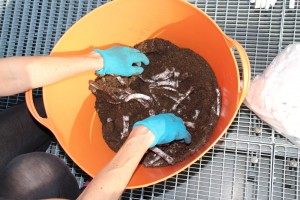
LITE-STRIPS for planting beds
LITE-STRIPS mainly act as a water reservoir. For this purpose the thick nonwoven strips are mixed into the soil. Up to 90% of the nonwoven volume can be filled with water thereby helping the plants to survive long drought periods.
With roof greening the high water absorption of the light nonwoven strips result in low weight compared to conventional materials such as expanded clay beads.
For aerating the lawns the strips are inserted vertically into the underground. Water and air from the surface are discharged in the subsoil. This process reduces the roots’ felting so they grow at a deeper level. This innovative technology of aeration offers long-lasting benefits.
What is LITE-NET?
LITE-NET discharge water and air excellently and are therefore suited for aeration and irrigation of plant roots. The nets are easily covered with soil and in some places they may be lifted up to the surface.
There the LITE-NET absorbs air and water in order to spread it most quickly and extensively at root level.
For slope greening the net with its high water storing capacity is installed directly at the surface. The extremely flexible net adapts perfectly to the ground and therefore improves erosion control. The University of Natural Resources and Life Sciences Vienna found out that the vegetation effect of LITE-NET was approx. 50% higher in comparison to coir mats because of the significantly higher water storage capacity.
How are LITE-SOIL products delivered?
LITE-NET is available pre-made or in roll form. The non-woven net can be easily cut by scissors or a knife from the roll.
LITE-STRIPS are delivered in small or big bags.
The nets delivered en bloc (e.g. 1.2 m width, 20 m length on roll) can be pulled apart to their multiple widths. The maximum width (e.g. 7.0 m) is specified in the data sheet each time, likewise the maximum surface (e.g. 80.6 m²) to be covered by the net. The maximum surface is not reached with the maximum width, but with a smaller width (e.g. 5.2 m).
What is BLUELITE-NET?

The active BLUELITE-NET system is a completely new and technically improved solution for water-saving underfloor irrigation for e.g. trees or sports fields.
It consists of a drip irrigation tube which feeds water into a protective geotextile cover (BlueLite-Cover) and further into a LITE-NET, where it is distributed over a large area at root depth. The geotextile coating distributes the water linearly along the irrigation tube, while increasing the water / soil contact area by a factor of 1,000 and protects the tube openings against root ingrowth and blockage caused by soil fines.
Subsurface irrigation eliminates evaporation, felting and surface waterlogging, reducing the cost of surface treatment. Irrigation is possible at any time and throughout, even if the lawn is being used or mowed. Because of the open and flexible shape of the net, there is no barrier at all; it can be laid at any depth, as plant roots can easily grow through or anchor themselves around the net, thus extracting 100% of the water stored in the net when needed. Even during the growth phase or in a plant mix, the plants are optimally supplied. Compared to spray irrigation, up to 70% water is saved.
What is the function of the non-woven protective tissue for BLUELITE-NET?
The non-woven protective tissue for the irrigation pipe serves mulitple purposes:
- Protection of the pipe orifices against ingrowing roots
- Protection of the pipe orifices against fine soil obstructions
- Lenghtwise water distribution along the irrigation pipe (important for soil mixes)
- Contact between the irrigation pipe and the distibution net
- Multiplies water/soil contact surface area by a thousand
- Mechanical protection of the irrigation pipe
- In case the irrigiation pipe breaks, it can be easily replaced in situ
At which depth should the irrigation pipe be installed for BLUELITE-NET?
In principle it should be installed at root depth, in case of fine soils it can also be installed at a deeper level.
In case of a posterior use of soil preparation machines and tools, the irrigation pipe should be deployed below the operating depth.
What should the distance be between the irrigation pipes for BLUELITE-NET?
The distance depends on the soil configuration and the intended use. In principle, the recommendation is 50 cm, although the distance can be increased in case of relatively impermeable soil or slope deployment.
What is BLUELITE-RING?
In existing trees, the BLUELITE-RING (a variant of the BLUELITE-NET without net) – a fleece-coated irrigation pipe – is led around the trunk in a ring at a depth of approx. 5-10 cm and connected with a stub line.
Advantages: No clogging of the irrigation openings by roots or fine particles. The escaping water is capillary distributed in the fleece jacket and irrigates the surroundings evenly over a very large contact area. Protection of the irrigation pipes against vandalism and UV influence. Personnel costs and water consumption are significantly reduced.
What is BLUELITE-AGRI?
Our cost-effective active underground irrigation BLUELITE-AGRI, a non woven -covered pipe that can also be laid in the ground without a distribution network, has been specially designed for retrofitting in existing plantations and for larger green areas and fields. The easiest way to lay it is to use devices for slotted drainage.
BLUELITE-AGRI is a cost-effective combination of a drip irrigation pipe with a protective, distributing and water-storing non-woven covering and is introduced underground at root depth.
BLUELITE-AGRI is intended for use in existing vineyards, orchards or fields. It can also be used on lawns, trees, bushes or in larger plant troughs.
Dieser Beitrag ist auch verfügbar auf: German Italian French Spanish Greek

